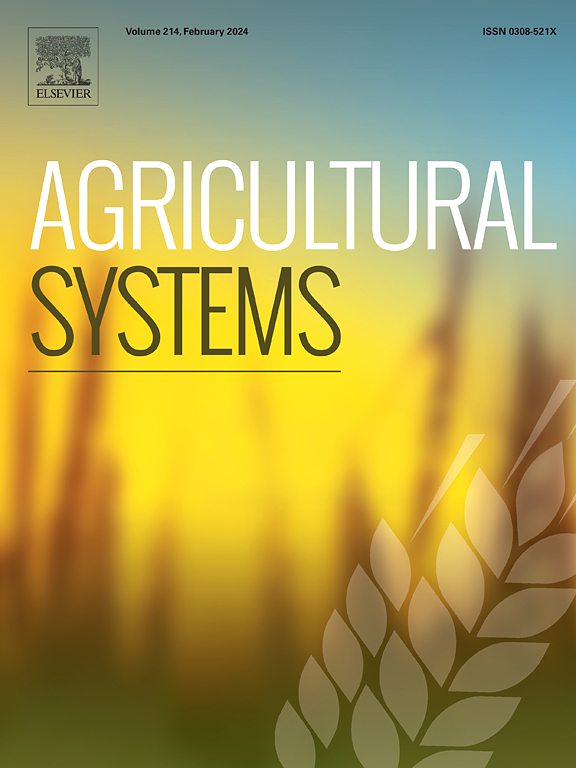Benefits and trade-offs from the diversification of rangeland farms in Northern Queensland, Australia
IF 6.1
1区 农林科学
Q1 AGRICULTURE, MULTIDISCIPLINARY
引用次数: 0
Abstract
CONTEXT
In Northern Queensland, farmers have limited information on options to increase resilience to climate variability and market volatility by diversifying production activities in large-scale rangeland grazing farms.
OBJECTIVE
To quantify benefits and trade-offs of co-designed diversification options of large-scale rangeland grazing farms in Northern Queensland.
METHODS
A diversification framework, specifically designed for large-scale farms (Adhikari et al., 2023), guided a participatory modelling exercise to co-design alternative production options. Two representative case-study farms, a dryland cropping (DC) and a dryland rangeland (DR), were selected from Northern Queensland's Gilbert region. Discussions with farmers were used to parameterise the APSIM model and simulate farmer's proposed alternative production systems. For DC, the baseline scenario was the existing dryland cotton-maize rotation, and the farmer's interest was to diversify into irrigated cotton, legume, and winter cereal rotations. For DR, the baseline scenario was growing dryland forages, and the diversification options included a dryland cotton-mungbean crop rotation. Benefits and trade-offs were quantified on economic, risk, environmental and social indicators.
RESULTS AND CONCLUSIONS
Irrigating legumes, and winter crops, alongside the existing cotton-maize rotation, increased the mean gross margin by ∼$1500 ha−1 year−1 and reduced downside risks by ∼25 % in the DC. Under irrigation, adding double-cropped winter-maize in rotation with cotton tripled ground cover and reduced erosion losses by ∼6 t ha−1 year−1. However, this was at the expense of a lower water-use efficiency ($ML−1), which was undesirable to the farmer. For the DR farm, the proposed dryland cropping increased downside risk by >65 % over the existing forage system, and reduced erosion by ∼3 t ha−1 year−1 reinforcing farmers' preference to maintain the current forage production system. In both cases, “peer-learning” emerged as the preferred method for upskilling as it does not necessitate substantial investment, is based on trust, and yet promises considerable positive impact in the farming business.
SIGNIFICANCE
Our results show that diversification doesn't always ensure positive outcomes. By co-designing options and quantifying benefits and trade-offs across multiple dimensions, discussions between researchers and farmers were better informed, allowing for improved decision making. Additionally, aligning diversification options with the local context and farmers' needs improves the likelihood of adoption and facilitates the scaling-up of these efforts. A major constraint includes inherent complexities of the participatory modelling approach that require skilling up of regional development agencies to actively engage and assist stakeholders for the agricultural development of Northern Australia.

澳大利亚昆士兰州北部牧场农场多样化的利益和权衡
在昆士兰州北部,农民对通过大规模牧场放牧农场多样化生产活动来提高对气候变化和市场波动的适应能力的选择了解有限。目的量化昆士兰北部大型牧场牧场共同设计多样化方案的效益和权衡。方法专门为大型农场设计的多样化框架(Adhikari等人,2023年)指导参与式建模练习,共同设计替代生产方案。两个代表性的案例研究农场,旱地种植(DC)和旱地牧场(DR),从昆士兰北部的吉尔伯特地区选择。与农民的讨论用于参数化APSIM模型,并模拟农民提出的替代生产系统。对于DC,基线情景是现有的旱地棉花-玉米轮作,农民的兴趣是多样化到灌溉棉花、豆类和冬季谷物轮作。对于旱地种植,基线方案是种植旱地牧草,多样化方案包括旱地棉花-绿豆轮作。根据经济、风险、环境和社会指标对收益和权衡进行了量化。结果和结论:在现有的棉花-玉米轮作的基础上,对豆科作物和冬季作物进行灌溉,每年可使该区平均毛利率提高约1500公顷,并将下行风险降低约25%。在灌溉条件下,两季冬季玉米与棉花轮作,土地覆盖面积增加了两倍,侵蚀损失减少了~ 6吨/公顷。然而,这是以较低的水利用效率($ML - 1)为代价的,这对农民来说是不可取的。对于DR农场来说,拟议的旱地种植比现有的饲料生产系统增加了65%的下行风险,并减少了约3公顷/年的侵蚀,这加强了农民对维持现有饲料生产系统的偏好。在这两种情况下,“同侪学习”成为提高技能的首选方法,因为它不需要大量投资,基于信任,而且有望对农业业务产生相当大的积极影响。我们的研究结果表明,多元化并不总是确保积极的结果。通过共同设计方案并在多个维度上量化收益和权衡,研究人员和农民之间的讨论得到了更好的信息,从而改进了决策。此外,将多样化选择与当地情况和农民的需求结合起来,可以提高采用的可能性,并促进这些努力的扩大。一个主要的制约因素包括参与式建模方法的固有复杂性,这需要提高区域发展机构的技能,以积极参与和协助利益相关者促进澳大利亚北部的农业发展。
本文章由计算机程序翻译,如有差异,请以英文原文为准。
求助全文
约1分钟内获得全文
求助全文
来源期刊

Agricultural Systems
农林科学-农业综合
CiteScore
13.30
自引率
7.60%
发文量
174
审稿时长
30 days
期刊介绍:
Agricultural Systems is an international journal that deals with interactions - among the components of agricultural systems, among hierarchical levels of agricultural systems, between agricultural and other land use systems, and between agricultural systems and their natural, social and economic environments.
The scope includes the development and application of systems analysis methodologies in the following areas:
Systems approaches in the sustainable intensification of agriculture; pathways for sustainable intensification; crop-livestock integration; farm-level resource allocation; quantification of benefits and trade-offs at farm to landscape levels; integrative, participatory and dynamic modelling approaches for qualitative and quantitative assessments of agricultural systems and decision making;
The interactions between agricultural and non-agricultural landscapes; the multiple services of agricultural systems; food security and the environment;
Global change and adaptation science; transformational adaptations as driven by changes in climate, policy, values and attitudes influencing the design of farming systems;
Development and application of farming systems design tools and methods for impact, scenario and case study analysis; managing the complexities of dynamic agricultural systems; innovation systems and multi stakeholder arrangements that support or promote change and (or) inform policy decisions.
 求助内容:
求助内容: 应助结果提醒方式:
应助结果提醒方式:


